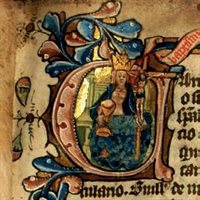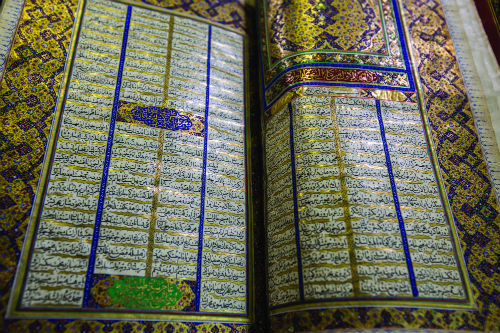 A few years ago, a group of nuns researching the history of their convent in Calcutta travelled to Birmingham to visit the Cadbury Research Library (CRL) – the only place in the world that could provide them with the information they sought.
A few years ago, a group of nuns researching the history of their convent in Calcutta travelled to Birmingham to visit the Cadbury Research Library (CRL) – the only place in the world that could provide them with the information they sought.
They wanted to know how far the boundaries of their religious community had extended over the years – and the answers lay among the historic rare books, manuscripts and archives held by the CRL in the collections of the Church Missionary Society, dating back to the 1700s.
“The Church Missionary Society collection – which is the most used of all our holdings – includes some of the earliest recorded details of pioneering explorations into Africa and Asia, often from missionaries writing back home,” explains Sue Worrall, Director of the University of Birmingham’s Special Collections. “There is a raft of fascinating material, from wives of missionaries expressing a desire to return to Britain to very early maps: we have the first map of Kilimanjaro, dating from 1848, hand-drawn by one of the missionaries.
“The collection is used by a range of international researchers as well as our own. People come here from Africa, the Middle East, Asia, New Zealand and North America; people who are interested in the history of their areas, such as the group of nuns from Calcutta.”
The CRL, based in the University’s Muirhead Tower, houses a wide range of historically, politically and culturally important collections accrued over 120 years, comprising more than 200,000 rare printed books, including significant incunabula (extant copies of books produced in the earliest stages – before 1501 – of printing from movable type) and more than four million items of unique archive and manuscript material.
The aim of the CRL, founded with a large donation from the Edward Cadbury Trust, is to support the University’s research, learning and teaching agenda, as well as helping external researchers from the UK and overseas.
The Special Collections have their origins in the library of the University’s forerunner, Mason College, founded in 1875 by Birmingham industrialist Josiah Mason. “So the heart of the collection was rare books, to which we started to add archive collections,” explains Sue.
Highlights of the rare book collections include important first editions, such as De Humani Corporis (1543) by Vesalius, the Complete Works (1616) of Ben Jonson and comprehensive collections of the works of Joseph Priestley and DH Lawrence. There are also major collections relating to the history of fine printing, including publications by John Baskerville and the Kelmscott Press of William Morris.

Among the manuscript and archive collections are the Mingana Collection, the Avon Papers – being the personal and political archive of former Prime Minister Anthony Eden, including material on the Suez Crisis – and the Chamberlain Collection, which comprises papers of the University’s founder Joseph Chamberlain and his sons Austen and Neville, another former Prime Minister, including letters and documents relating to his summit meetings with Hitler.
The collections, which are kept in temperature- and humidity-controlled accommodation, consist of material that has been donated by individuals and organisations, transferred from libraries, bought – often at auction – and taken on long-term loan. There is also the University’s own heritage archive.
“So some of the archive collections are our own – mainly the rare book collections – but a lot of our holdings, such as the archives of Save the Children, YMCA and YHA, are held on long-term deposit. We manage them and make them available for research,” says Sue.
Not only do the collections get viewed on-site; material is lent for exhibitions and events. This year, for example, two letters from the collections, referring to the imprisonment of Sir Oswald Mosley and his wife Diana under Defence Regulation 18B, whereby British subjects thought to be Nazi sympathisers were interned without trial, were displayed in the British Library’s Magna Carta: Law, Liberty, Legacy exhibition.
“We continue to add to the collections, which are extremely wide-ranging: there are clay tablets dating from 2500BC and Save the Children material from as recently as 2005,” says Sue, who has headed the CRL for nine years.
“We have policy guidelines in terms of what we collect, but we do consider material on a case-by-case basis. At the moment, for example, we are looking at the MAC (Midland Arts Centre) archive collection and also a collection of rare polar exploration books. We turn down a lot: We are offered things regularly, but we will say no if they don’t fit with our collecting policy.
“As well as being offered material, we will actively seek it out if it fills a gap in a particular collection or enhances areas in which we are already strong. So it’s about proactively managing what we’ve got and looking to enrich it.”
The CRL’s 20-strong team of archivists, librarians, conservators and support staff have to manage the vast collections virtually as well as physically: as well as online cataloguing, there is the Virtual Manuscript Room, where external researchers can view high quality digital scans of original material.
“It’s important to have a comprehensive online catalogue so that people know what is here. Not everything is online yet, but that’s the aim.”
Sue, a qualified archivist who previously worked in Oxford, Melbourne and as Coventry’s city archivist, says the CRL’s focus remains unchanged after more than a century. “We’re an international research hub, but ultimately we are here to serve our own academics and students. Most students will never have been in this kind of library before – where you might get to handle a Charles Dickens first edition in original parts or a Jamaican plantation lease alongside letters by a liberated slave. This kind of exposure to collections really brings subjects to life for our students; it makes them real.”